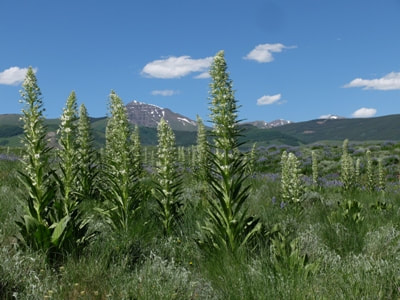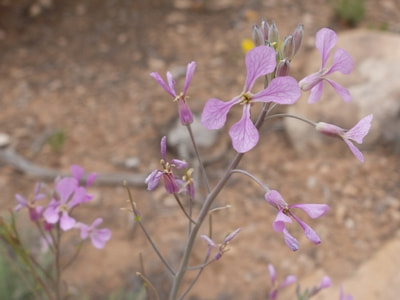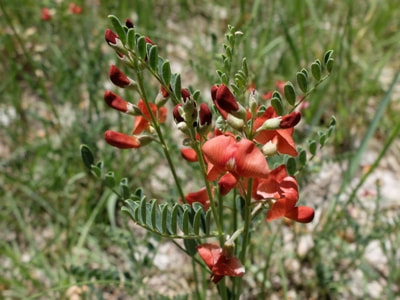Monument Plant, Elkweed, Green Gentian, Deer Ears,Frasera speciose,Gentian Family (Gentianaceae)7/19/2019 Found in moist meadows and conifer forests
Seen blooming in July along Brush Creek, Gunnison Valley, CO I am writing this week from 8,025 feet in cool Colorado (low 42°, high 78°). The spectacular Monument Plants are in full bloom here but they can also be found over 8,500 feet in the Abiquiú area. At first they could be mistaken for Mullein but a closer look will show the four large, light green, speckled petals of the flowers. The Monument Plant produces a flower spike from 5 to 7 feet tall with hundreds of flowers on the stem. It flowers in synchronization with other plants. Some believe it can live up to 80 years as a rosette of long, strap-like leaves and dies after producing the flower spike. The roots were used to treat diarrhea, colds, stomach troubles, gonorrhea and asthma, and to kill lice, while a plaster of the leaves was used to treat headaches. A cold compound infusion was rubbed on hunters and their horses to lend strength and the long stalk was used to make elk calls during hunting. Source. If you are trying to identify a different flower then you can check what other flowers bloom this month. If you cannot identify a flower from the website send a photo and where you took it to contact@rockymountainsflora.com. Read online for tips.
0 Comments
Pink Windmills, Slimleaf Plainsmustard,Schoenocrambe linearifolia,Mustard Family (Brassicaceae)7/12/2019 Found in dry, rocky areas
Seen blooming in June/July/August in Plaza Blanca Grows to 4 feet, erect and tall in an airy pattern. Leaves are grayish green, long and narrow. The flower has four spoon-shaped purplish-pink petals with purple veins. Seedpods are long and slender. It has been used in ceremonial medicine and as eye medicine. Source. If you are trying to identify a different flower then you can check what other flowers bloom this month. If you cannot identify a flower from the website send a photo and where you took it to contact@rockymountainsflora.com. Read online for tips. Found in dry, open areas
Seen blooming in July in Poshuouinge, Santa Fe National Forest The dainty Plains Flax has been blooming since May but it is easy to miss because it is only 8 inches tall with narrow leaves and the color of the flower blends into the areas where it grows. The slender stem and leaves are covered in dense hairs which make them appear gray. The flower is less than one inch across with a copper-colored center and produces a small berry. You may find another yellow flax blooming now, the Bristle Flax, which is similar but taller and has shiny petals. Traditionally the berry juice was squeezed into the eye for inflammation, leaves were used to treat heartburn, while flowers were used to make yellow paint and an infusion of the plant taken to kill a swallowed red ant. Source. If you are trying to identify a different flower, then you can check what other flowers bloom this month. If you cannot identify a flower from the website send a photo and where you took it to contact@rockymountainsflora.com. Read online for tips. Found in disturbed moist areas, roadsides, ditches, alkaline soil
Seen blooming in June in Abiquiu This is a long-lived perennial growing up to four feet tall with short white hairs on the stem and many oval leaflets. Its brick-red flowers fade to a light brown-purple when they dry. Seed pods are bladder-like and translucent, and become papery when dry. It is native to Asia but it is known in many other parts of the world as an introduced species and often a noxious weed. It grows in cultivated land and disturbed habitat, easily tolerating alkaline soil. It is commonly seen in areas where alfalfa is grown, because the seeds of the two species look similar and the weed seed is easily imported with the crop seed. It also reproduces by sprouting vigorously from its creeping root system. Alkaloids in the plant may make it poisonous to livestock. In Asia it is used as a folk medicine for treatment of hypertension. I have added a couple of new features to the website. A while ago my niece and I published a book called "My Wildflower Friends". I decided to put it out there so that it can be shared with a kid, or anyone who is a kid at heart. Tap on 4Kids to see it. A lady called Wanda asked me if I would publish the Abiquiú Bloom Blog as a booklet. I decided that with over 100 blooms in the blog there is too much for a booklet, so I have made it easy to print the "Blooming by Month" pages using your browser's print function to make your own booklet. You can decide the way it prints. I found that a scale of 70% and "Portrait" prints a month neatly on two pages. You can print bigger images if you print at 100% in Landscape mode. I hope you find it useful. If you are trying to identify a different flower then you can check what other flowers bloom this month. If you cannot identify a flower from the website send a photo and where you took it to contact@rockymountainsflora.com. Read online for tips. Found in sagebrush scrub and forest openings
Seen blooming in June near FS Road 137 in Carson National Forest Last Saturday I took an excellent hike with Kirt Kempter to the rim of Copper Canyon as a reward for donating to the AAESP firetruck fund and learned a lot about the geology of this awesome place we call home. Go online to sign up for future events and to donate. Many different flowers bloom at over 8,000 feet in elevation and Lupine is one of the showiest. They are characterized by their tall spikes of pea-shaped flowers which are usually blue/purple but can be white or pink. Their leaves are divided, spreading like the fingers of a hand, and this species has fine hairs on its stems and the underside of the leaves. They grow from 1 to 3 feet tall in masses, the height and density of the foliage varies by site and moisture. The Navajo applied a poultice of crushed leaves to poison ivy blisters. Some lupines are edible and the beans are a traditional food in some cultures but many contain poisonous alkaloids and should be avoided. Their pods look like hairy pea pods and could be eaten by children. The FDA warns against lupin flour and lupin protein used in gluten-free products if people are allergic to peanuts. Source. If you are trying to identify a different flower then you can check what other flowers bloom this month. If you cannot identify a flower from the website send a photo and where you took it to contact@rockymountainsflora.com. Read online for tips. |
AuthorI am Marilyn Phillips, a native of England, whose love of nature and the outdoors from childhood brought me by a circuitous route to Crested Butte, Colorado in 1993 and 16 years later to northern New Mexico. My exploration of the many trails in these areas, my interest in wildflowers and photography, and career in computer system design came together in this creation. If you have any corrections, comments or questions, please contact me by email. Archives
September 2024
Categoriescopyright © 2020
|







 RSS Feed
RSS Feed